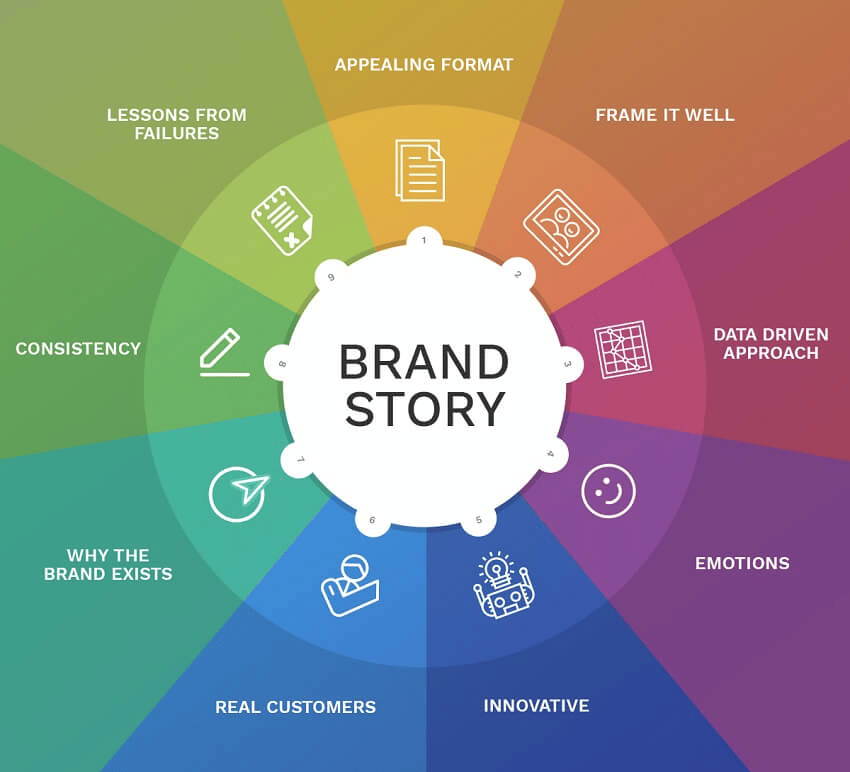Brand storytelling in marketing is the strategic use of narratives to engage and connect with customers, enhancing brand identity and awareness. It involves creating compelling stories that resonate with the target audience, highlighting the brand’s values, mission, and uniqueness.
Through effective brand storytelling, marketers can establish an emotional connection with consumers, differentiate their brand from competitors, and drive customer loyalty and engagement. When done well, brand storytelling can effectively captivate and persuade customers, positively impacting their purchasing decisions. In today’s competitive business landscape, where consumers are bombarded with information and have endless options, brand storytelling has become an essential tool for companies to cut through the noise and leave a lasting impression.
Crafting Compelling Narratives
Crafting Compelling Narratives: Crafting a brand story that captivates the audience is crucial for effective marketing.
Connecting With Emotions
Emotions play a pivotal role in capturing the attention of the audience in brand storytelling.
Building Authenticity
Authenticity is the cornerstone of a compelling brand narrative, fostering trust and loyalty.

Credit: www.skyword.com
Utilizing Multiple Platforms
When it comes to brand storytelling in marketing, utilizing multiple platforms is key to reaching a wider audience and engaging with them in a meaningful way. With the rise of digital marketing, brands now have the opportunity to connect with consumers through various channels such as social media, content marketing, and more. In this section, we will explore how businesses can make the most of these platforms to effectively tell their brand story and connect with their target audience.
Social Media Engagement
Social media has revolutionized the way brands interact with their consumers. With billions of people active on various social media platforms, it has become an essential tool for brand storytelling. To engage with your audience effectively, it’s important to:
- Create compelling and shareable content that evokes emotions and resonates with your target audience.
- Use storytelling techniques like captivating visuals, impactful videos, and relatable narratives to tell your brand story.
- Interact with your audience by responding to comments, addressing their concerns, and initiating conversations.
- Collaborate with influencers and industry experts to amplify your brand message and reach a larger audience.
- Analyze the performance of your social media campaigns using analytics tools to understand what resonates with your audience and optimize your strategy accordingly.
Content Marketing Strategies
Content marketing is a powerful tool for brand storytelling, as it allows businesses to create valuable and relevant content that educates, entertains, and inspires their target audience. Here are some effective strategies to utilize:
- Create a content calendar that outlines the topics and formats you’ll be using to tell your brand story.
- Produce high-quality content that offers unique perspectives, addresses pain points, and provides practical solutions to your audience.
- Optimize your content for search engines by incorporating relevant keywords and meta tags.
- Promote your content through various channels, such as social media, email marketing, and guest blogging, to reach a wider audience.
- Engage with your audience by encouraging comments, responding to feedback, and inviting them to share their own stories related to your content.
- Measure the success of your content marketing efforts by tracking metrics such as website traffic, engagement, and conversions.
Creating Memorable Brand Characters
Personifying The Brand
A great way to make your brand stand out is by creating memorable brand characters. Personifying your brand allows you to connect with your audience on a deeper level as they feel a sense of familiarity and relatability. By giving your brand a distinctive personality, you can establish a unique identity that sets you apart from the competition. Whether it’s a brand mascot or a fictional character representing your brand, this approach humanizes your brand and makes it more approachable for your target audience.
Eliciting Emotional Connections
Emotions play a crucial role in consumer decision-making, and by creating memorable brand characters, you can elicit emotional connections with your audience. When people emotionally connect with a brand, they are more likely to develop a sense of loyalty, trust, and affinity towards it. A well-crafted brand character that evokes positive emotions can tap into your audience’s desires and aspirations, making them more receptive to your brand message and ultimately increasing brand recall and customer engagement.

Credit: marketinginsidergroup.com
Measuring Storytelling Impact
Tracking Engagement Metrics
Engagement metrics are vital for measuring the success of brand storytelling efforts. Utilize tools to track interactions, such as click-through rates and social media shares.
Assessing Brand Perception
Brand perception reflects how audiences perceive your storytelling. Surveys and focus groups can provide insights into how effective your brand story is.
Challenges And Opportunities
Navigating brand storytelling in marketing presents both challenges and opportunities. Crafting a compelling narrative that resonates with audiences can lead to increased brand loyalty and engagement. However, the saturated digital landscape and short attention spans require strategic and authentic storytelling to stand out and make a lasting impact.
Navigating Consumer Skepticism
` In the realm of brand storytelling, marketers encounter the dual challenge of consumer skepticism and the vast opportunities to build brand loyalty through compelling narratives. Navigating these hurdles requires a strategic approach that acknowledges the power of storytelling and proactively addresses consumer concerns. While the power of storytelling in marketing is undeniable, it faces the obstacle of consumer skepticism. With the saturation of marketing messages in the digital sphere, consumers have become increasingly discerning. They often question the authenticity and credibility of brand stories, creating a barrier for marketers. However, it is essential to recognize that this skepticism can be overcome with a thoughtful and genuine approach to brand storytelling. `Leveraging Storytelling For Brand Loyalty
` Yet, amidst these challenges lie significant opportunities for brands to leverage storytelling to cultivate loyalty. Crafting authentic narratives that resonate with the audience fosters a deep emotional connection, leading to sustained brand loyalty. By effectively communicating the brand’s values, mission, and personality through storytelling, marketers can create a sense of belonging and trust among consumers. Moreover, the digital landscape provides a multitude of platforms for brands to disseminate their stories. From social media to branded content, brands have ample opportunity to engage with their audience in meaningful ways. This presents an opening for organizations to harness the power of storytelling to cultivate lasting relationships with consumers. In conclusion, while the challenges of consumer skepticism persist, the capacity for brand storytelling to drive loyalty and engagement is immense. By acknowledging these obstacles and strategically employing storytelling, brands can not only captivate their audience but also foster enduring brand loyalty.
Credit: www.krishaweb.com
Frequently Asked Questions Of Brand Storytelling In Marketing
What Are The Four Elements Of Brand Storytelling?
The four elements of brand storytelling are character, setting, plot, and conflict. Each contributes to creating a compelling narrative that engages the audience.
What Are The 4 P’s Of Storytelling?
The 4 P’s of storytelling are Plot, Point of view, Protagonist, and Purpose. These elements help structure and create a compelling narrative.
What Is An Example Of A Brand Story?
Nike’s brand story is a prime example. It showcases their dedication to helping athletes achieve their full potential through innovation and inspiration. Their iconic “Just Do It” slogan encapsulates their ethos, making them a powerful and globally recognized brand.
What Is The Story Telling Strategy Of Marketing?
Storytelling strategy in marketing involves using compelling narratives to connect with customers emotionally, making the brand more relatable and memorable. This approach helps in creating brand loyalty and driving customer engagement and loyalty.
Conclusion
Storytelling is the heart of brand marketing strategy. Through compelling narratives, brands connect with audiences on a deeper level. By integrating storytelling into marketing efforts, brands can create authenticity and build emotional connections. Embrace the power of storytelling to elevate your brand presence and engage with your audience effectively.
